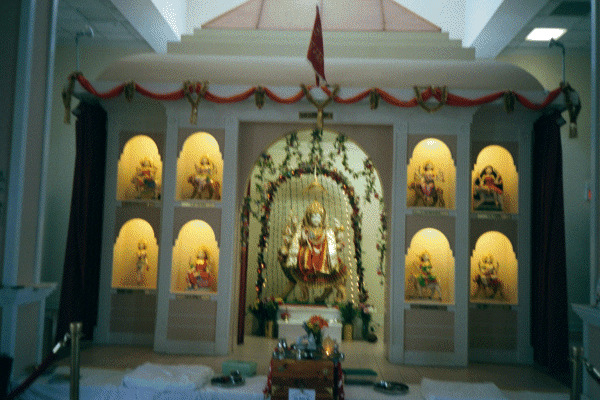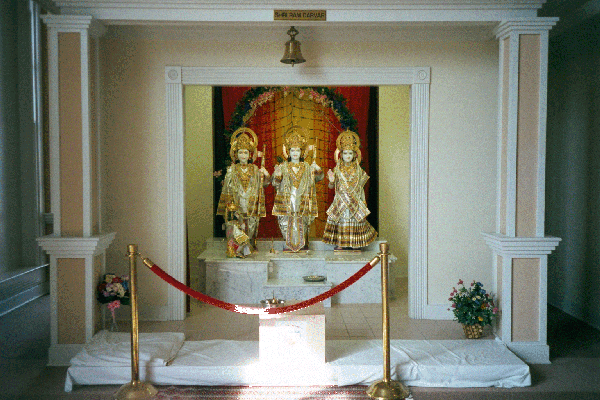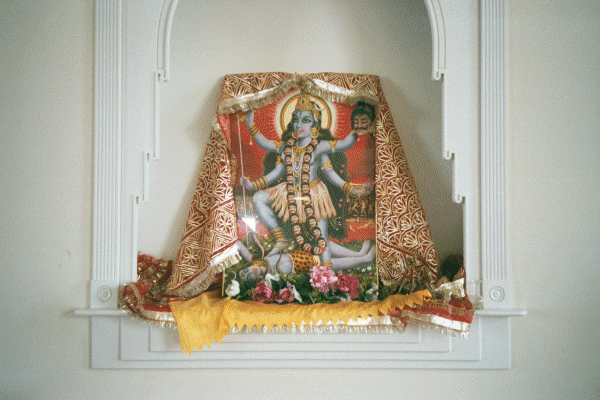|
On Friday morning, I visited the Durga Temple in Virginia. I wanted to be there when the temple opened at 0900 so that I could observe some devotees performing puja. I knew that the temple was fairly close to me, but I allowed some extra travel time just in case traffic was bad. I arrived at 0845 and was shocked to see only two cars in the parking lot. I decided to wait a little while - in my car- to gather my nerves, organize my thoughts.. and wait for more people to arrive. The latter of the three had not occurred by 0905, so I went on in. The temple was an eye catcher: spacious, clean, bright. I took notice of the food that was available in the entrance hall, it showed signs of handling... that meant that someone had taken some. At that, I thought that there may be more people than I assumed present in the temple... like maybe they walked, entered through another door and carried their shoes on their person. I headed for to the interior of the temple and saw above the door in the second hall, a statue of Ganesh and wondered, why Ganesh and not Durga. I opened the door to the worship hall and realized that there were more deities present than people, so I had to make as much contact with the worshippers as possible.... it wasn't that easy. I had the opportunity to see a gentleman perform parts of his puja which included fire, bell ringing, and chanting. I initially thought that Hindus would choose one or two deities at a time for worship (depending on their stage in life), but during the ceremony the gentleman went to each of the altars set up for deities Durga (located at center), Krishna, Hanuman, Ram and Sita, and Shiva. I was unable to talk to him, but I did make contact with another worshipper and one of the temple priest.
The worshipper explained to me some of the steps in puja. He stated that the devotee will sit and pray or ask the god to join him or come into his presence as he worships and that they will place the dot on their head before starting puja. He also explained that "aarti" is performed after puja is complete. The food (prasad) in the hall, he stated, is for all worshippers at the temple to share or use in puja... if you were unable to bring some with you, the temple has provided for you. He also pointed out to me that the statue of Durga was holding up only eight hands instead of ten, but placed around her large main statue are eight smaller statues. Each statue represents the strengths, aspects, skill, duties that Durga performs. He had to leave, so I walked around a bit. While walking around, I noticed that all of the deities were dressed in fine clothing, with gold weaving, they wore necklaces, and each alter had fruit and flower offerings, and money. I thought the money was a little strange, but a temple priest explained to me that the money is left as a donation to the care of the deity, for instance around the worship hall, there were lots of pictures standing in recessed boxes in the walls and money was left in front of many of them. He explained that the temple is in the process of acquiring statues for these other deities, and the money is a donation towards the purchase. I noticed a picture of Kali, and while talking to the priest he mentioned that we are in the beginning stage of Kali Yuga and that the incarnation of Kali will come towards the end of the time period. And for the first time I made the connection, Kali destroys evil and Kali Yuga is the period of turmoil and evil... duh!
There was a stage in the temple, off to the side, and Teo (another Religions of the world student) asked about the purpose. The priest said that it used in special ceremonies, classes taught to some devotees, or for English translation. He remarked about the difficulty Indian Americans would have understanding the traditions and some of the ceremonies, and that in the area of the stage is where these things would be explained to them. This explanation allowed me to see how the religion is coping with the changes in the Indian society and culture. There was music playing in the temple but not during a puja. I attempted to ask why, but I guess this question got lost in between the many others. I assume it would distract the devotee during his worship. The priest had to go, but informed Teo and I that Sunday evening would be a great time to come back and visit because there would be community worship and Indian food served afterwards. He invited us to return and bid us farewell. So despite the small amount of worshippers present, I gained a wealth of knowledge by observing and speaking with two people. It was definitely worth the trip. |
| Created by Laura Ellen Shulman |
Last updated: April 2002
|


